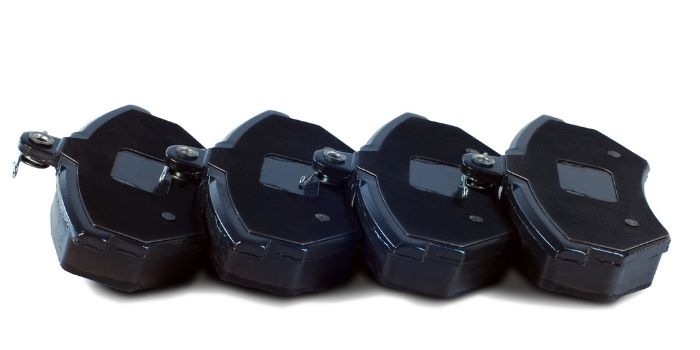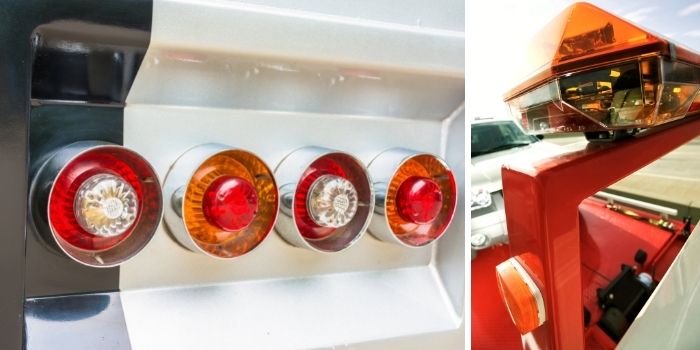Brake pads are an essential part of any vehicle’s braking system.
Since they are responsible for providing the friction that stops the wheels from turning, they take a lot of abuse in the process.
When the time comes for replacement, it’s essential to choose the right type from the several different types of materials on the market – including organic, ceramic, and semi-metallic brake pads.
Since all have pros and cons, based on your specific condition, one may be a better fit for your needs than the other.
But in general, here’s what you need to know about each type to make the best decision…
Table of Contents
Ceramic Brake Pads
Traditionally the brake pads are made from iron and steel because these pads are very strong and durable, but they can also be quite noisy.
As a result, ceramic brake pads are becoming increasingly popular because they offer good performance without the noise of metal pads.
Ceramic brake pads are made of a mixture of ceramic and metal fibers. The metal fibers help to give the pad its strength, while the ceramic fibers help to dissipate heat.
They are also designed to offer superior braking performance in wet and dry conditions. However, the major drawback is they are more expensive and can wear out more quickly in some conditions.
The Pros
- Offer superior braking performance in both wet and dry conditions
- Quieter than metal pads and works consistently in a wide range of conditions
- Comes with excellent stopping abilities and is unlikely to produce a lot of brake dust
The Cons
- Expensive than other alternatives
- Can wear out quickly and can be a bit harsher on brake rotors than organic pads
- Not best suited for frigid climates or extreme-duty usage like racing
Organic Brake Pads
Organic brake pads are made from various materials, including Kevlar, glass, and rubber. These pads are softer than metal or ceramic pads, creating less noise.
The rubber in the pad material helps to absorb shocks and vibrations, while the Kevlar helps to provide strength and durability.
Organic brake pads are designed to offer good braking performance in both wet and dry conditions. And that’s the reason organic they are now used on more than 70% of new cars and trucks.
However, the drawback is they also wear down more quickly and may not perform as well in cold weather.
The Pros
- Economically priced
- Offers sufficient cold-bite
- Operates quietly with superior daily driving performance
- Offer good braking performance in both wet and dry conditions
- Quieter than metal or ceramic pads
- Produces less dust than semi-metallic options
The Cons
- Wear down more quickly
- It may not perform as well in cold weather
- Not best for demanding driving conditions
- In the operational temperature range, they’re pretty limited
- The compressibility rate is lower than that of other brake pad types
Are Semi-Metallic Brake Pads Good?
Semi-metallic brake pads are made from a mixture of metal and organic materials, offering the best of both worlds.
These types of metallic brake pads are made of 35-65% metal, where the type of metals incorporated may vary.
The metal fibers in the brake pades help to give strength, while the organic materials dissipate heat.
They are also more resistant to brake fade, which is when the pads stop working as effectively after extended use.
However, semi-metallic brake pads can be quite noisy and may not be the best choice for vehicles with a lot of city driving.
The Pros
- Stunning stoppage ability with superior cold-bite
- Offers excellent high-heat performance
- Resistant to brake fade
- Low rate of compressibility
- Offer superior braking performance in both wet and dry conditions.
The Cons
- It can be quite noisy
- Produces more brake dust
- It can be harder on brake rotors
- They are more expensive than organic ones
Do I Need to Purchase Rotors with Brake Pads?
No, you don’t need to purchase rotors with brake pads.
Brake pads can last anywhere from 20,000 to 40,000 miles, depending on the type of brake pad and the driver’s driving habits.
Whereas the rotors can last anywhere from 30,000 to 70,000 miles, so they usually don’t need to be replaced as often as brake pads.
If you’re experiencing brake issues, it’s always a good idea to have your brakes inspected by a professional to see if you need new rotors.
The cost of replacing brake pads and rotors can vary depending on the type of brake pad and the make and model of your vehicle.
Generally, you can expect to spend anywhere from $100 to $300 on a complete brake pad and rotor kit replacement.
However, the cost will be significantly less if you’re only replacing the brake pads. For example, brake pads for Silverado 1500 can be replaced for less than two hundred dollars.
So, Which Brake Pad Material is Best for Your Trucks and Cars?
The best type of brake pad for your car or truck depends on various factors, including driving habits, vehicle type, and budget.
When choosing brake pads, you must consider the type of driving you do most often and what trade-offs you are willing to make in terms of performance, noise, and cost.
- For example, ceramic brake pads may be the best choice if you do a lot of city driving or mountain driving because they offer good performance without being too noisy.
- On the other hand, if you do a lot of highway driving, semi-metallic brake pads may be the best choice because they offer superior performance and resistance to brake fade.
- Organic brake pads are a good choice for those who want a quiet ride, but they may not offer the same performance level as other brake pads.
Ultimately, the best type of brake pad for your car or truck depends on your specific needs and driving habits.
Be sure to do your research and choose the brake pad that will work best for you and your vehicle.

Based in Orem (Utah) John Paterson graduated from Utah Valley University and has begun writing in 2009. He has a large wealth of experience in writing articles related to cars, automotive repair, wheels, cleaning/maintenance, and much more. He has also written instructional articles in a similar niche for a few online publications as well. Currently, he works as a mechanic in his personal garage shop where he loves serving his countrymen from his heart.






